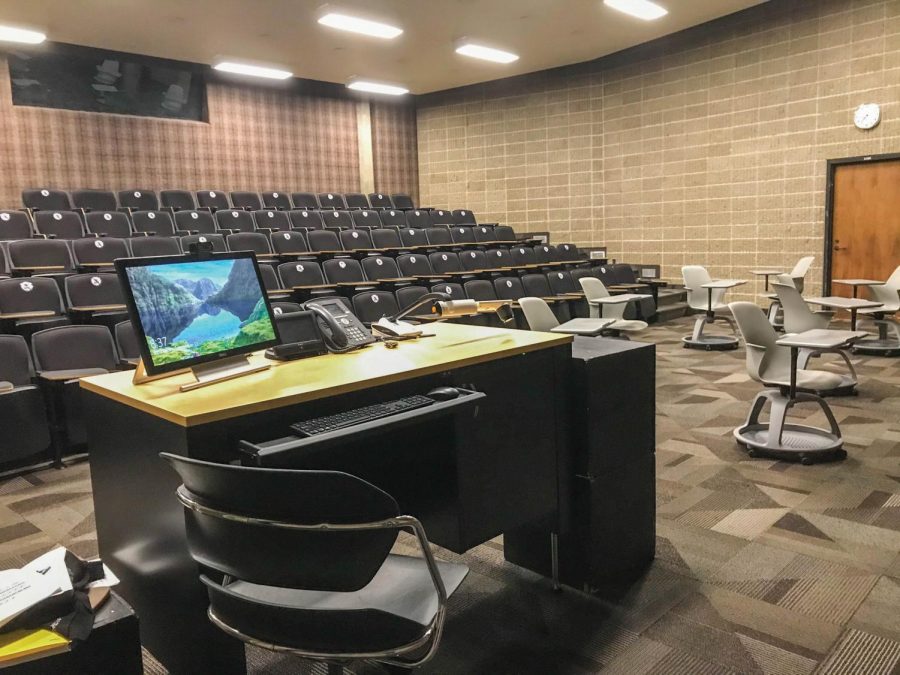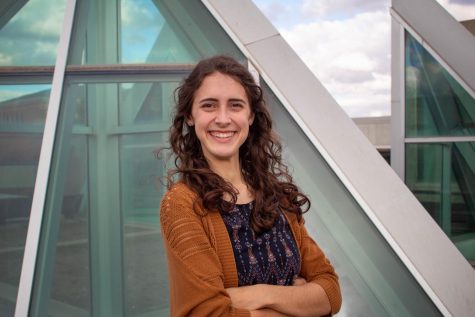Some in-person classes opt for online
CAC 108 sits empty as the Department of Communications and Disorders decides ASL instructor Katie O’Briens classes are no longer meeting in-person.
Sep 28, 2020
According to UNI’s COVID-19 reopening plan as detailed at forwardtogether.uni.edu, the fall 2020 semester began with over 80% of classes meeting fully or partially face to face and only 20% being fully online.
However, now that it is halfway through the semester, a number of classes have temporarily converted online due to illnesses or COVID-19 exposures. Others, for various reasons, have gone completely remote or online.
Lucia Jaime Hernandez, a junior elementary education major, recently had two of her classes converted to remote learning.
“Personally, the shift is worse,” she said. “I have a hard time focusing online and I can get easily behind in class.”
However, she noted that there are some advantages, such as the opportunity to still participate in class if she is sick or otherwise unable to attend in person.
Katie O’Brien, American Sign Language (ASL) instructor, recently converted all her classes, which had been meeting in-person, to online delivery via Zoom. While some classes have moved online due to COVID-19 exposures, O’Brien’s decision to go remote was pedagogical. When she taught in person, she needed to wear a mask, and it was difficult for students to see her face, an issue in the visually-based language of ASL.
O’Brien said that while moving her classes online didn’t involve paperwork, she did have to notify the department chair, who then notified the registrar’s office.
Her decision to move online also involved a lot of back and forth as she tried to ensure that her students understood her decision.
“Initially, I surveyed my classes the first week to ask them how they felt about moving ‘online.’ I had to go back and clarify that I meant ‘remote,’ as in we would still meet during our regular class meetings, just via Zoom, and that I wasn’t abandoning them/throwing them to the wolves/ghosting them,” she explained.
She also commented that she did not know why her class would assume such a thing, but still she changed the survey to help them better understand the question.
“I think many of them were apprehensive, but I sort of slowly moved them to Zoom to have them try it out,” said O’Brien. “They were much more interactive and responsive on Zoom than in the classroom! I think seeing my whole face makes a big difference for them.”
Nonetheless, some of her students were still not very happy with the change, and after receiving a “complaint,” she decided to return to in-person. However, she soon realized that it may not have been the best thing for the students’ learning.
“The statistical data I got from their exam grades showed that they were struggling to understand me, which I greatly attribute to them not seeing my entire face,” she said. “Armed with that data, I was able to make the professional decision to permanently shift all my class meetings to Zoom for the remainder of the semester.”
Unlike O’Brien’s decision, though, some class shifts did not involve student opinions, as mentioned by Sophia Aguirre, a strategic public relations major.
Aguirre had one class that went online temporarily, as well as other classes which shifted to online learning before the semester began.
“I actually was not notified about this change from any of my classes that did end up going online,” she said. “I was instructed by my advisor that I should check MyUNIverse regularly over the summer to make sure I was staying up-to-date with the changes. One of my classes changed its lecture room three times in the course of two months before moving completely to online learning via Zoom. As far as I am aware, I nor anyone else in my online classes were involved in the decision-making process.”
Aguirre also talked about the difference in the quality of education between in-person and online classes.
“I definitely feel like I can get more out of my in-person classes … I believe I am retaining information better,” she said. “Not only that, but having the luxury of hands-on, collaborative learning makes such a big difference in my personal learning experience, more in fact than I thought it would.”
Still, some students appreciate their professors’ dedication to keeping them safe, acknowledging that most of the shifts may have been due to bigger class sizes.
Natalie Newhard, also a junior elementary education major, had an in-person class move online temporarily. She said the shift was “due to seating being too close together and people getting sick.”
“I appreciate the caution from my professors and the school because I don’t want to get sick or pass on sickness,” she said.









